
Amaryllis is the only genus in the subtribe Amaryllidinae. It is a small genus of flowering bulbs, with two species. The better known of the two, Amaryllis belladonna, is a native of the Western Cape region of South Africa, particularly the rocky southwest area between the Olifants River Valley and Knysna.

Chives, scientific name Allium schoenoprasum, is a species of flowering plant in the family Amaryllidaceae that produces edible leaves and flowers. Their close relatives include the common onions, garlic, shallot, leek, scallion, and Chinese onion.

Corm, bulbo-tuber, or bulbotuber is a short, vertical, swollen underground plant stem that serves as a storage organ that some plants use to survive winter or other adverse conditions such as summer drought and heat (perennation).

Iridaceae is a family of plants in order Asparagales, taking its name from the irises. It has a nearly global distribution, with 69 accepted genera with a total of c. 2500 species. It includes a number of economically important cultivated plants, such as species of Freesia, Gladiolus, and Crocus, as well as the crop saffron.

A perennial plant or simply perennial is a plant that lives more than two years. The term is often used to differentiate a plant from shorter-lived annuals and biennials. The term is also widely used to distinguish plants with little or no woody growth from trees and shrubs, which are also technically perennials.Notably, it is estimated that 94% of plant species fall under the category of perennials, underscoring the prevalence of plants with lifespans exceeding two years in the botanical world

Gladiolus is a genus of perennial cormous flowering plants in the iris family (Iridaceae).
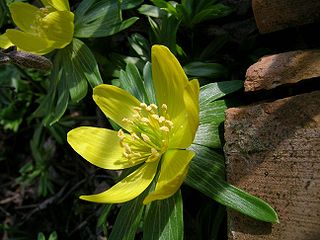
Eranthis is a genus of eight species of flowering plants in the buttercup family Ranunculaceae, native to southern Europe and east across Asia to Japan. The common name winter aconite comes from the early flowering time and the resemblance of the leaves to those of the related genus Aconitum, the true aconite. Like the notoriously toxic AconitumEranthis is poisonous, although its chemistry is different, the toxic compounds present being mainly cardiac glycosides of the bufadienolide group similar to those found in Adonis vernalis, rather than the virulent alkaloids of Aconitum.

Hyacinthus orientalis, the common hyacinth, garden hyacinth or Dutch hyacinth, is a species of flowering plant in the family Asparagaceae, subfamily Scilloideae, native to southwestern Asia, southern and central Turkey, northwestern Syria, Lebanon and northern Israel. It was introduced to Europe in the 16th century. It is widely cultivated everywhere in the temperate world for its strongly fragrant flowers which appear exceptionally early in the season, and frequently forced to flower at Christmas time.
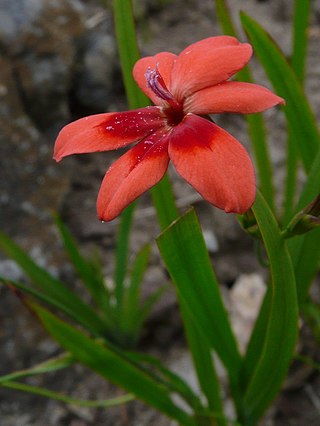
Freesia laxa, commonly known as flowering grass, is a small species of cormous flowering plant in the family Iridaceae, from eastern and southern Africa, from Kenya to northeastern South Africa. It is grown in gardens as an ornamental plant.
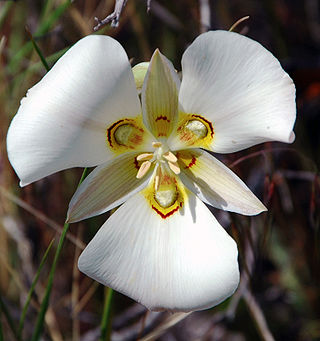
Calochortus nuttallii, also known as the sego lily, is a bulbous perennial plant that is endemic to the Western United States. The common name of sego comes from a similar Shoshone word. It is the state flower of Utah.

Drimia maritima is a species of flowering plant in the family Asparagaceae, subfamily Scilloideae. This species is known by several common names, including squill, sea squill, sea onion, and maritime squill. It may also be called red squill, particularly a form which produces red-tinged flowers instead of white. It is native to southern Europe, western Asia, and northern Africa.
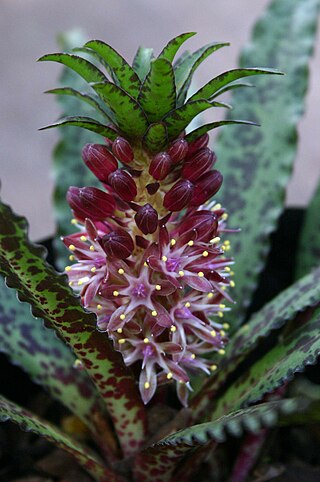
Eucomis vandermerwei is a South African bulbous perennial flowering plant, a member of the asparagus family, and like other members of Eucomis is commonly known as pineapple lily for its superficial resemblance to that plant, although not closely related to it. This species is one of the smallest in the genus, and is native to a high-rainfall region of western Mpumalanga in South Africa. The dense rosette of leaves, either prostrate or ascending, is heavily blotched with purple, and the leaf-edges are markedly crisped or wavy. The star-shaped burgundy flowers appear in midsummer, and are borne on a spike (raceme) topped by a "head" of leafy bracts.

Ornamental bulbous plants, often called ornamental bulbs or just bulbs in gardening and horticulture, are herbaceous perennials grown for ornamental purposes, which have underground or near ground storage organs. Botanists distinguish between true bulbs, corms, rhizomes, tubers and tuberous roots, any of which may be termed "bulbs" in horticulture. Bulb species usually lose their upper parts during adverse conditions such as summer drought and heat or winter cold. The bulb's storage organs contain moisture and nutrients that are used to survive these adverse conditions in a dormant state. When conditions become favourable the reserves sustain a new growth cycle. In addition, bulbs permit vegetative or asexual multiplication in these species. Ornamental bulbs are used in parks and gardens and as cut flowers.
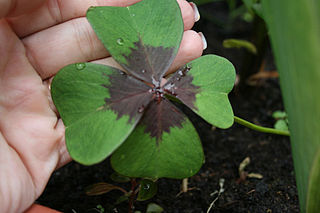
Oxalis tetraphylla is a bulbous herbaceous perennial plant from Mexico. It is sometimes sold as lucky clover or shamrock. In the wild or feral state it is often called four-leaved wood-sorrel after its family, Oxalidaceae. Other English common names for this plant include Lucky Clover, Four-Leaf Sorrel, Four-Leaf Pink-Sorrel and others. It is sometimes called "the iron cross plant" or "oxalis iron cross" because the leaves loosely resemble the iron cross symbol, though this name is not a classic folk term and has fallen out of favour due to the bad political connotations associated with this symbol.

Tecophilaea cyanocrocus, the Chilean blue crocus, is a flowering perennial plant that is native to Chile, growing at 2,000 to 3,000 m elevation on dry, stony slopes in the Andes mountains. Although it had survived in cultivation due to its use as a greenhouse and landscape plant, it was believed to be extinct in the wild due to overcollecting, overgrazing, and general destruction of habitat, until it was rediscovered in 2001.

Iris bucharica is a species of flowering plant in the family Iridaceae. It is a bulbous herbaceous perennial, from temperate Asia, within Afghanistan, Tajikistan and Uzbekistan. It has long blue green leaves, many flowers in spring, in shades of yellow and white.
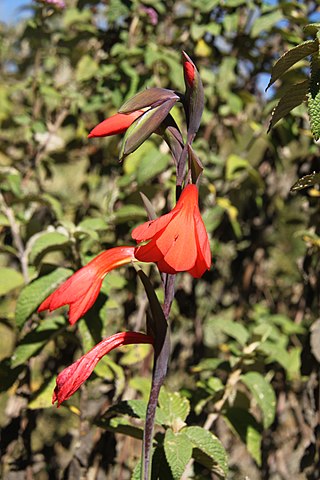
Gladiolus watsonioides is a medium to high (½–1 m), herbaceous geophyte with sword-shaped leaves, flattened in the plain of the stem, and spikes of red funnel-shaped flowers, that is assigned to the iris family. In the wild, the species is restricted to the highlands of central Kenya and northern Tanzania, including on Kilimanjaro, Mount Kenya and the Aberdare Range. It is sometimes called Mackinder's gladiolus.
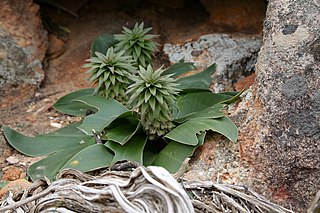
Eucomis regia is a species of bulbous flowering plant in the family Asparagaceae, subfamily Scilloideae, native to the Cape Provinces of South Africa. It is sometimes cultivated, but requires protection in a greenhouse in temperate climates.
Eucomis amaryllidifolia is a species of flowering plant in the family Asparagaceae, subfamily Scilloideae, native to the Cape Provinces. It is a short, summer-flowering bulbous plant, with a dense spike (raceme) of yellowish-green flowers topped by a "head" of leafy bracts. In Afrikaans it is called kliplelie.




















